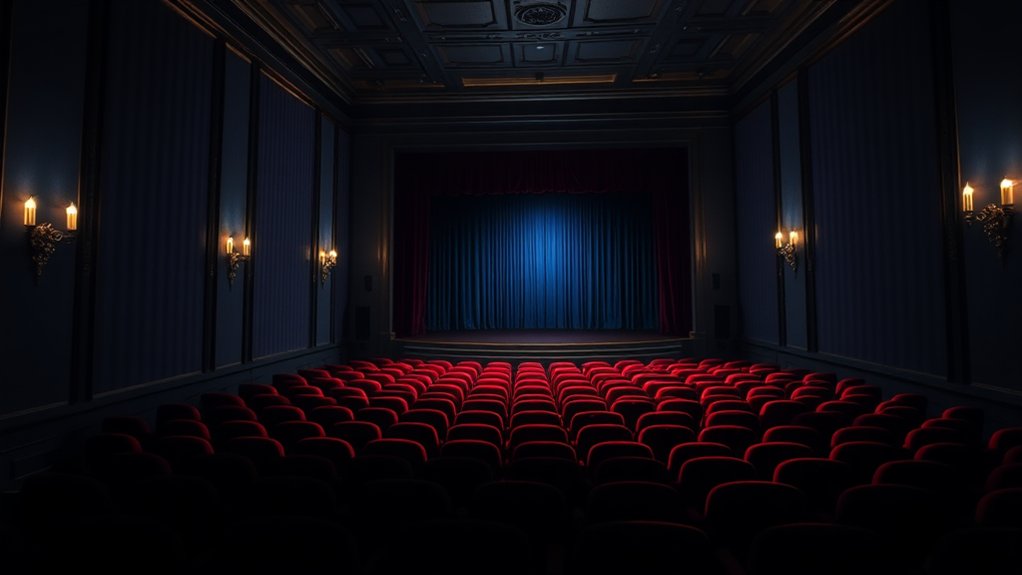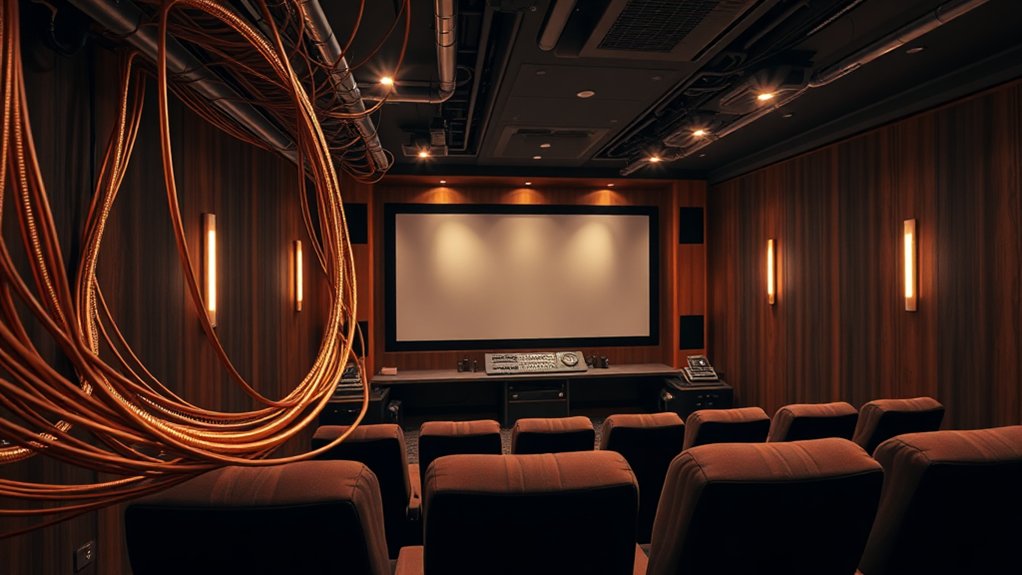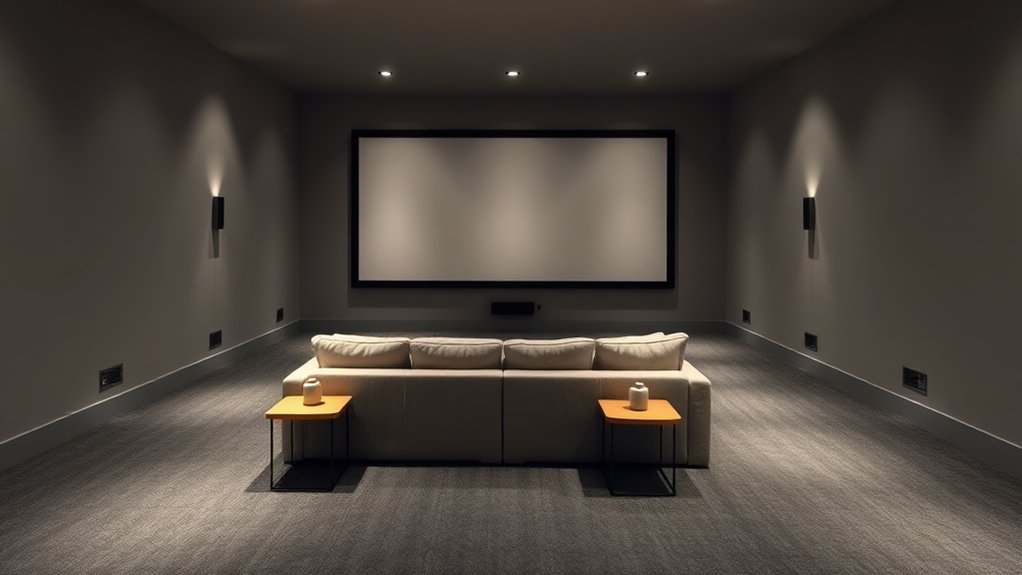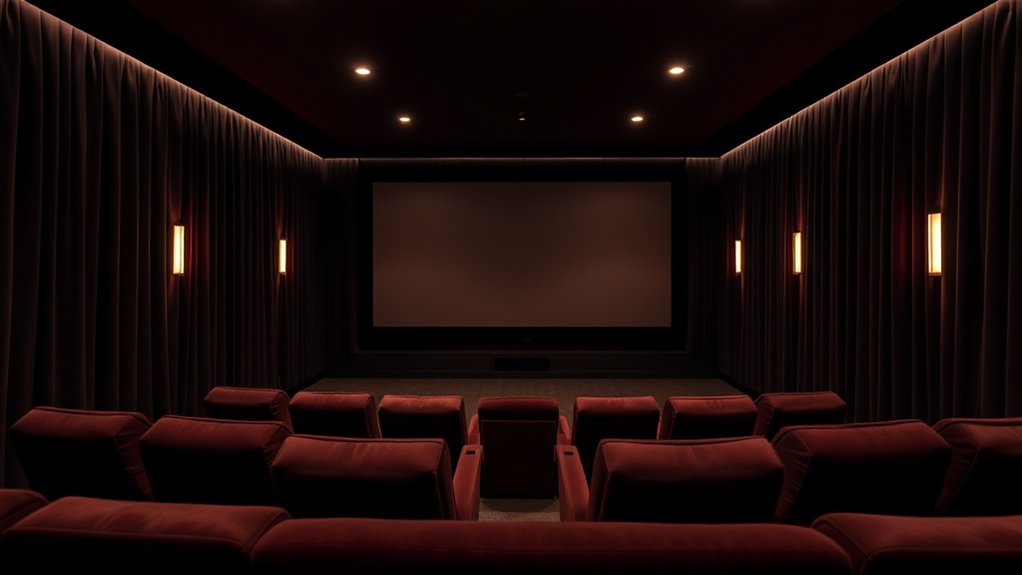Choosing dark colors for theater walls isn’t just about style; it considerably improves your viewing experience. Dark hues absorb light, preventing glare, and helping maintain image clarity on the screen. Plus, they enhance sound quality by reducing echoes and creating a more immersive atmosphere. Think of it as setting the stage for a great performance—without distractions! If you’re curious about how these choices affect other aspects of your space, there’s plenty more to reveal.
Key Highlights
- Dark colors absorb light, enhancing image clarity and minimizing reflections on the projection screen.
- They reduce echoes and reverberations, providing superior sound quality during film screenings.
- Dark hues create an intimate atmosphere, fostering viewer engagement and emotional connection to the film.
- They hide dirt and imperfections, simplifying maintenance while ensuring a pristine appearance.
- Dark walls offer aesthetic versatility, complementing various design styles and allowing creative staging opportunities.
Light Absorption and Reflection Control
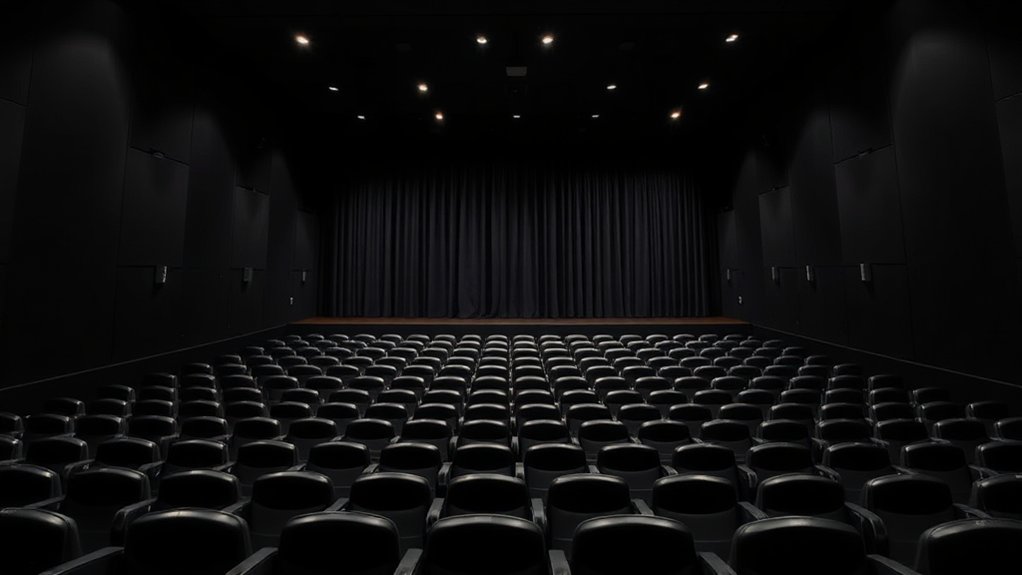
When you think about painting theater walls, you mightn’t immediately consider the science behind color choices, but it plays a huge role in enhancing your viewing experience. Dark colors are excellent at absorbing light, which means less bounce around the room. Imagine sitting through a climactic scene, only to be distracted by unnecessary glare—no thanks! By opting for dark, matte finishes, you minimize light reflection, preventing that annoying ambient light interference. Plus, certain specialized coatings not only trap even more light but can furthermore reduce sound echoes, making your movie-watching experience that much better. Fundamentally, dark walls create a focused, immersive atmosphere, allowing your projector’s vivid colors to shine without distortion or interruptions. Additionally, the right light absorption techniques can significantly increase the overall visual quality of your theater space. Interestingly, the design of zeolite frameworks demonstrates how structural properties can influence performance, highlighting the importance of material choice in creating optimized environments.
Contrast Enhancement
Even though many might overlook the importance of wall colors in a theater, darker hues play a critical role in enhancing contrast for your viewing pleasure.
Dark walls absorb excess light, preventing unwanted reflections that can muddy the clarity of the image—ever watched a film in a bright room? You know that washed-out look!
With black or dark gray hues, you actually boost the perceived brightness of projected images. They not only make colors and details pop but additionally create a seamless visual experience, pulling your focus to the screen. In fact, darker environments eliminate light spilling onto the projection screen, facilitating an improved contrast ratio. Moreover, using dark colors for walls complements your speaker installation as it minimizes potential comb filtering effects that can disrupt sound clarity.
Plus, dark surroundings eliminate distractions, allowing for a deeper emotional connection to what you’re watching.
In short, the darker the walls, the sharper and more lively the movie magic becomes!
Acoustic Benefits
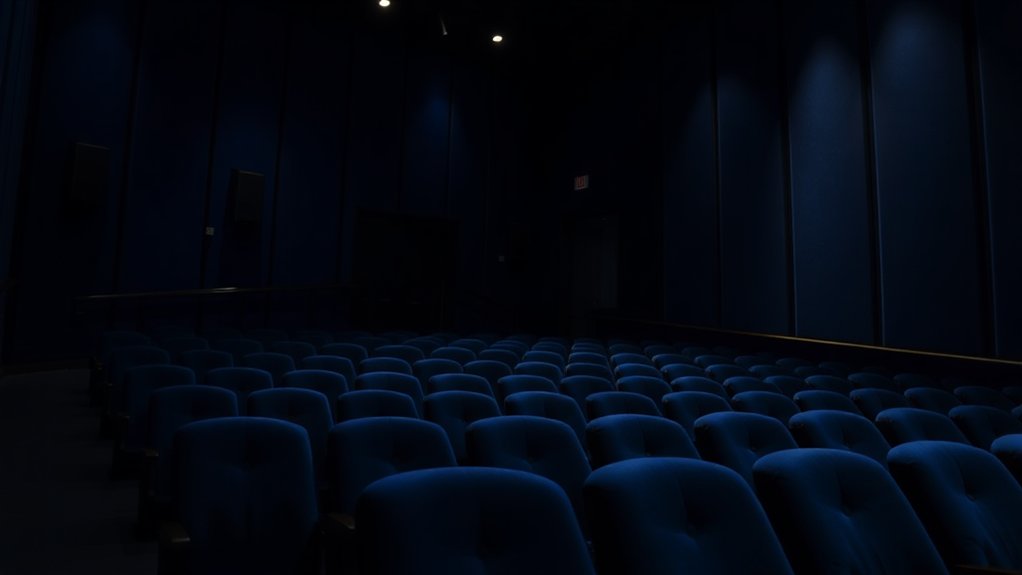
As you’re soaking in the cinematic magic of deep colors improving your viewing experience, it’s important not to overlook another significant benefit of dark theater walls: their acoustic properties.
Dark walls often feature higher-density materials that absorb sound waves, reducing echoes and those annoying reverberations. Think about it—who wants dialogue muffled by bouncing sound? Additionally, many commercial settings use SilentCeiling™ Black Theater Board to further enhance sound absorption.
Materials like black fiberglass panels boast noise reduction coefficients (NRC) up to 1.0, which means they absorb sound really well. This not only keeps external noise at bay, but it additionally improves the clarity of what you actually want to hear: the movie’s intricate sound design.
Ambiance and Mood Creation
Though you might be tempted to think of dark colors merely as a design choice for your theater walls, they play a pivotal role in crafting the atmosphere and enhancing the overall mood of your viewing experience. When you choose deep hues, like navy or burgundy, you not only create intimacy but additionally absorb ambient light, reducing reflections that can distract your focus.
Imagine sinking into a plush seat surrounded by colors that evoke drama and warmth—this cozy environment invites relaxation and encourages social interaction.
Sinking into a plush seat amid warm, dramatic colors fosters relaxation and invites social connections.
Dark walls additionally boost the cinematic illusion, framing your screen beautifully as they enhance contrast and image clarity.
In short, dark colors help your theater feel both elegant and immersive, perfect for escaping reality for a time.
Design Versatility and Aesthetic Appeal
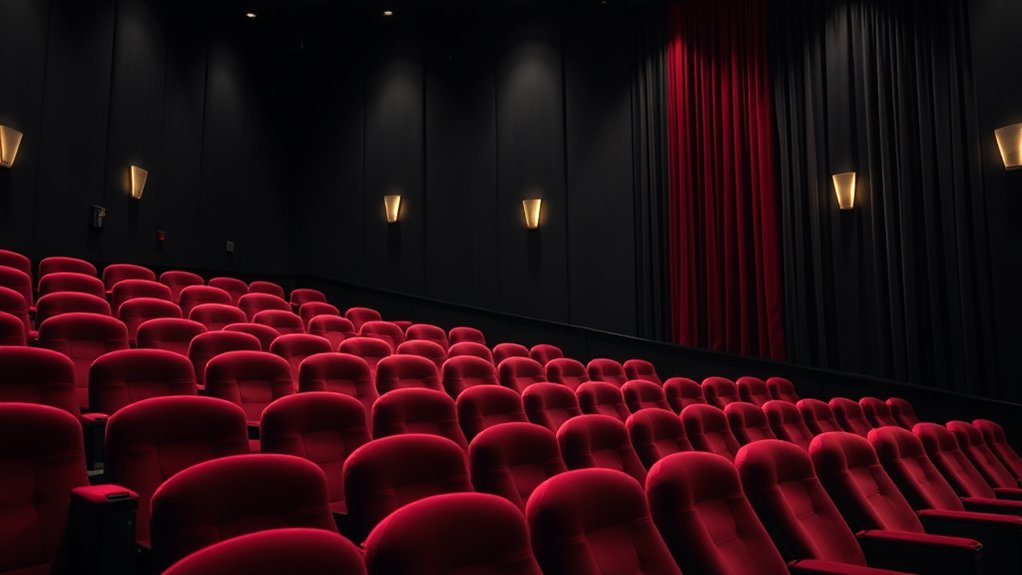
In the domain of designing your home theater, you mightn’t realize just how dark colors can improve both versatility and aesthetic appeal. Dark walls act as a neutral backdrop, letting your décor shine without clashing—think of them as the reliable friend in your design story.
They harmoniously blend with various materials, whether it’s sleek metals or rustic wood, making them perfect for any décor style you envision. Plus, dark tones make technology disappear, allowing your large TV to feel like part of the room rather than its bossy cousin.
This adaptability means you can effortlessly switch up your accent colors as trends change. So, why not give your space that sophisticated, timeless vibe you’ve always wanted?
Practicality and Maintenance
Though you’ve certainly enjoyed examining the elegant aesthetic of dark colors in your home theater, let’s explore how these shades furthermore bring practicality to the table.
Dark walls excel at hiding dirt, dust, and those annoying little smudges that seem to sneak in when you’re engrossed in a movie marathon. Imagine fewer cleaning sessions and minor wall imperfections being masked effortlessly! Maintenance is a breeze, as a quick dusting with a microfiber cloth keeps grime at bay.
Moreover, dark colors minimize glare, enhancing your viewing experience. With their durability, dark paints often require fewer touch-ups, saving you time and money over the years.
It’s like having a stunning background that works overtime while you enjoy your cinematic adventures!
The Psychological Impact of Color
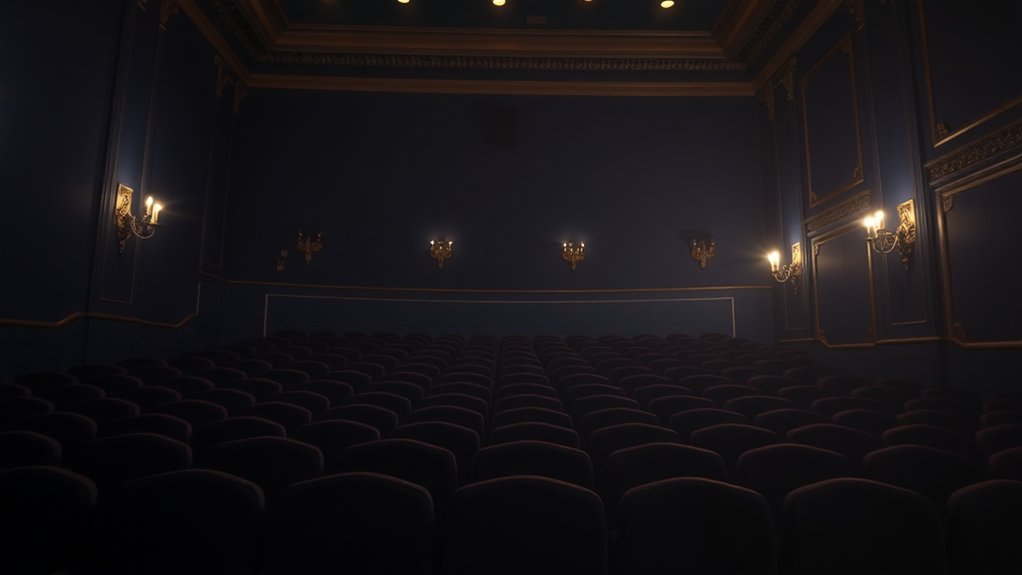
Color psychology plays a fascinating role in your home theater experience, influencing not just how the space looks, but moreover how you feel during immersion in cinematic narratives.
Dark colors, like deep red or burgundy, absorb light, decreasing glare and promoting focus, concurrently evoking a sense of prestige reminiscent of historic theaters. They help create an intimate environment that cocoons you, minimizing distractions, so you can plunge deeper into the film’s emotional essence.
Dark hues, like deep red, foster focus and intimacy, transforming your space into a cinematic sanctuary that enhances emotional connection.
Although some might argue dark shades lead to gloominess, used thoughtfully, they provide comfort and calm—perfect for cinematic escapes. Plus, doesn’t that cozy atmosphere just feel perfect for binge-watching?
When chosen wisely, dark colors set the scene for a truly immersive viewing experience.
Popular Dark Color Choices for Home Theaters
As you consider how to improve the immersive experience of your home theater, the choice of wall color takes center stage.
Popular dark shades like charcoal gray or dark gray offer a sleek, modern look during absorbing excess light, enhancing your projector’s clarity.
If you’re after ultimate contrast, black walls are your go-to, but keep in mind they might make your space feel a bit smaller.
Dark blues, like navy, bring a cozy vibe without the starkness of black, perfect for winding down after a long day.
For a bold flair, deep reds evoke a theatrical ambiance, and earthy tones like dark brown can create a natural retreat.
Which vibe speaks to you? Well, the choice is yours!
Frequently Asked Questions
How Do Dark Colors Affect Room Temperature in Theaters?
Dark colors absorb more heat, making theaters warmer by trapping warmth from ambient light and equipment. This can improve comfort but may increase cooling demands in warmer climates, affecting your overall HVAC efficiency.
Can Dark Walls Influence the Viewing Distance From the Screen?
Yes, dark walls can influence your viewing distance. They absorb light, reducing glare and making images appear sharper, which allows you to sit closer comfortably without losing picture quality or experiencing eye strain.
What Are the Best Painting Techniques for Achieving Dark Colors?
To achieve dark colors, properly prep surfaces and use high-quality, tinted primers. Apply thin, even coats of matte or flat finishes, allowing adequate drying time to guarantee a rich, consistent appearance without streaks or imperfections.
Do Dark Colors Impact Lighting Design Options in Home Theaters?
Yes, dark colors considerably impact your lighting design options in home theaters. They improve contrast, minimize glare, and allow for versatile ambient settings, enabling you to create an enchanting viewing experience tailored to your preferences.
How Do Dark Theater Walls Affect Resale Value of a Home?
Dark theater walls can enhance your home’s perceived value, especially in luxury markets. They create an immersive atmosphere that buyers appreciate, but may narrow interest, impacting resale potential based on local buyer preferences.

